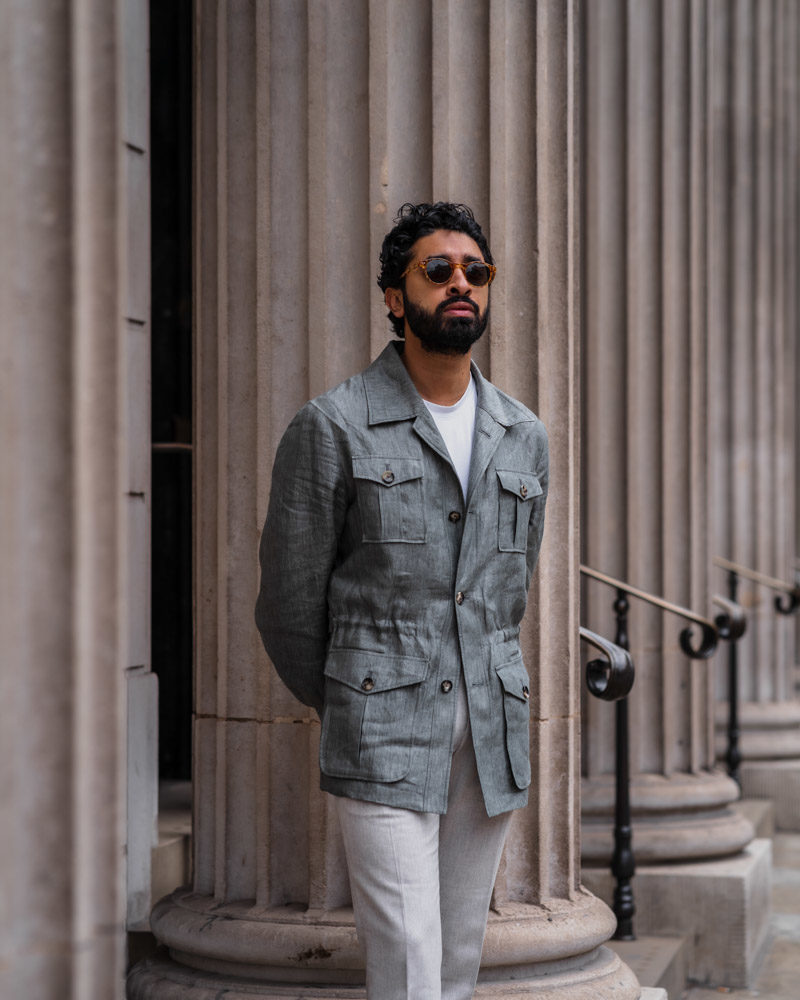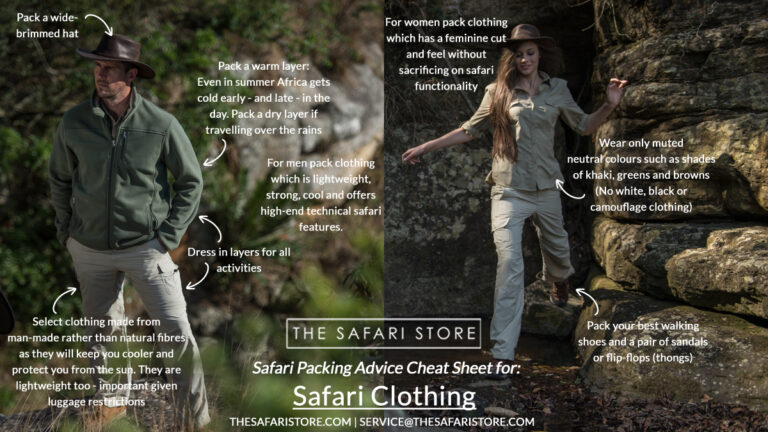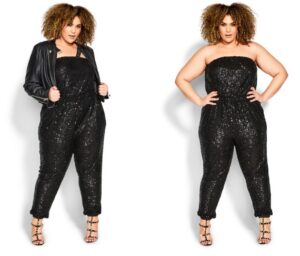For an African safari, it is important to wear neutral-colored, lightweight, and comfortable clothing. Embarking on an African safari requires careful consideration of what to wear to ensure comfort and functionality in the diverse and often rigorous conditions of the continent.
Clothing should ideally be lightweight, neutral-colored, and breathable to cope with the warmth and humidity of the African climate. Additionally, it is recommended to wear long sleeves and long pants to protect against mosquitoes and other insects. Comfortable and sturdy footwear, such as closed-toe shoes or boots, is also essential.
It’s crucial to avoid bright colors, as they may attract unwanted attention from wildlife. By following these guidelines, safari-goers can fully enjoy their wildlife adventure while staying safe and comfortable in their clothing choices.
Essential Safari Clothing Items
When planning for an African safari, it’s important to pack the right clothing items to ensure a comfortable and enjoyable experience. One essential item to include in your safari wardrobe is lightweight and breathable shirts that will keep you cool in the hot African weather. Another important consideration is neutral-colored pants or shorts, which will help you blend in with the natural surroundings and avoid attracting unwanted attention from animals.
A safari vest or jacket with multiple pockets is a practical choice as it allows you to carry essential items such as sunscreen, insect repellent, and a camera without the need for a separate bag. Additionally, a wide-brimmed hat is essential for sun protection and to shield your face and neck from harmful UV rays. Lastly, don’t forget to pack comfortable and sturdy closed-toe shoes that will provide support and protection during long walks and game drives.
Dressing For Different Weather Conditions
When planning what to wear on an African safari, it’s important to consider the diverse weather conditions. Layering options for cool mornings and evenings are essential for staying comfortable throughout the day. It’s also crucial to pack rain gear for tropical climates as rain showers can be frequent. Additionally, sun protective clothing is a must for hot and sunny days to shield yourself from harmful UV rays. For colder safaris, thermal clothing should be included in your wardrobe to keep you warm and cozy. Finally, it’s important to be prepared for unpredictable weather by packing versatile pieces that can be easily layered or removed as needed. By considering these tips, you can ensure that you are dressed appropriately for any weather conditions during your African safari.
The Importance Of A Good Safari Bag
When embarking on an African safari, it is crucial to have a good safari bag that can withstand the rugged conditions of the wilderness. A spacious and durable backpack or duffel bag is essential to carry all your belongings comfortably and keep them protected from the elements.
When choosing a safari bag, there are several important features to consider. Firstly, the bag should have ample capacity to accommodate your clothing, gear, and essentials for the duration of your trip. Look for a bag made from hard-wearing materials such as canvas or nylon, which can withstand wear and tear in rough environments.
It is also beneficial to have a bag with multiple compartments to help organize your belongings and allow easy access to items when needed. Additionally, waterproof or water-resistant properties are desirable to protect your belongings from unexpected rain or splashes during river crossings.
Some recommended brands and styles for safari bags include Osprey, North Face, and Patagonia. These brands often offer backpacks and duffel bags specifically designed for outdoor adventures, with features tailored to the needs of travelers on safari.
Must-have Safari Accessories
When packing for an African safari, there are several must-have accessories that will enhance your experience. Binoculars are essential for wildlife spotting, allowing you to get a closer look at the magnificent animals you encounter. These powerful optical tools will enable you to capture amazing safari moments from a distance.
Camera gear is another essential item for documenting your safari adventure. Make sure to pack a high-quality camera or a smartphone with excellent camera capabilities to ensure you can take stunning photos or record videos of the incredible wildlife you encounter.
Personal care items and toiletries are crucial for staying comfortable during your safari. Be sure to pack insect repellents and sunscreens to protect yourself from pesky bugs and the harsh African sun. Additionally, a well-stocked first aid kit with essential supplies is essential for any unforeseen emergencies.
| Must-Have Safari Accessories: | Binoculars for wildlife spotting |
|---|---|
| Camera gear | For capturing amazing safari moments |
| Personal care items and toiletries | Insect repellents and sunscreen |
| Essential first aid kit supplies |
Efficient Packing Techniques
Efficient packing techniques are crucial when preparing for an African safari. One strategy is to choose between rolling and folding your clothes. Rolling clothes can help save space and reduce wrinkles, making it easier to pack essentials. Utilizing packing cubes can also ensure organization throughout your trip. These cubes allow you to categorize different items, making it easier to find what you need without unpacking your entire suitcase. Additionally, maximizing space in your luggage is essential. Methods such as using compression bags or vacuum-sealed storage can help minimize the bulkiness of your clothing and create more room for other necessities. By employing these efficient packing techniques, you can ensure a stress-free and enjoyable safari experience.
Planning For Laundry And Dress Code Expectations
Planning for laundry and dress code expectations is an important aspect when preparing for an African safari. With limited laundry facilities available on safari, it is essential to strategize packing light and plan for designated laundry days.
Packing light is crucial to ensure that you have enough space in your luggage for the essentials. Consider packing versatile clothing items that can be mixed and matched for different safari activities. Opt for lightweight and breathable fabrics such as cotton or synthetic blends, as they provide comfort in the hot and humid weather.
When it comes to laundry days, check with your safari lodge or camp beforehand to understand their laundry policies. Some accommodations may offer laundry services, while others may have self-service facilities. By planning ahead, you can determine when and where to do your laundry, allowing you to pack accordingly.
Regarding dress code expectations, safari lodges and camps typically have specific guidelines to maintain a respectful and appropriate atmosphere. It is recommended to avoid bright or neon-colored clothing, as they can attract insects or wildlife. Neutral and earthy tones are preferable, as they blend well with the surroundings and are less likely to startle animals.
By following these guidelines, you can ensure that you are appropriately dressed while enjoying your African safari adventure.
Conclusion (do Not Include The Heading “conclusion”)
Summary of key points covered in the article:
– Choosing appropriate clothing for an African safari is of utmost importance. It helps protect from the harsh sun, insects, and other elements you may encounter.
– Balancing style, comfort, and practicality is crucial while planning your safari outfits. Although you might be tempted to prioritize fashion, it’s essential to prioritize comfort and functionality.
– Opt for lightweight, breathable fabrics such as cotton or linen that offer sun protection and allow for easy movement. Avoid bright colors that can attract insects.
– Layering is key, as temperatures can fluctuate dramatically throughout the day. Pack a few versatile pieces that can be dressed up or down.
– Consider sturdy, closed-toe shoes that provide support and protection for walking on various terrains.
– Don’t forget to pack a wide-brimmed hat, sunglasses, and a high-quality sunscreen to shield yourself from the sun’s strong rays.
– Finally, keep in mind the cultural and environmental considerations of the region you’ll be visiting. Dress respectfully and avoid clothing that may harm the local ecosystem.

Credit: www.senszio.com
Frequently Asked Questions Of What To Wear On African Safari
What Kind Of Clothes To Wear On An African Safari?
Wear light, breathable and neutral-colored clothes on an African safari for comfort and to blend in with nature. Opt for long sleeves, long pants and a hat to protect against insects and the sun. Bring sturdy and comfortable footwear.
What Is Best Clothing To Wear On Safari?
The best clothing to wear on safari is lightweight, neutral-colored clothing that blends with the environment and protects from the sun. Opt for long-sleeved shirts, long pants, and a wide-brimmed hat. Comfortable closed-toe shoes and a lightweight jacket may be needed for cooler mornings or evenings.
What Should A Woman Wear On A Safari?
On a safari, women should wear lightweight, neutral-colored clothing and comfortable footwear. Opt for breathable fabrics like cotton and linen to stay cool. Don’t forget a hat, sunscreen, and insect repellent. Avoid bright colors and heavy perfumes that could attract wildlife.
Dress modestly and respect local customs.
What Not To Wear On Safari?
Avoid wearing bright colors or flashy clothing on safari as they may attract animals and disturb their natural behavior. Also, stay away from revealing outfits and opt for lightweight, breathable clothes that provide sun protection. Don’t forget to wear sturdy, comfortable footwear and leave expensive jewelry at home.
Conclusion
To ensure a comfortable and enjoyable African safari experience, it is essential to dress appropriately for the diverse climates and wildlife encounters. By opting for lightweight, breathable clothing in neutral colors, you can blend in with the surroundings while staying cool.
Don’t forget to protect yourself from the sun with a wide-brimmed hat and sunscreen. Additionally, packing sturdy, closed-toe shoes and insect repellent will help you navigate the terrain with ease. With the right wardrobe, you’ll be ready to embark on an unforgettable safari adventure!





